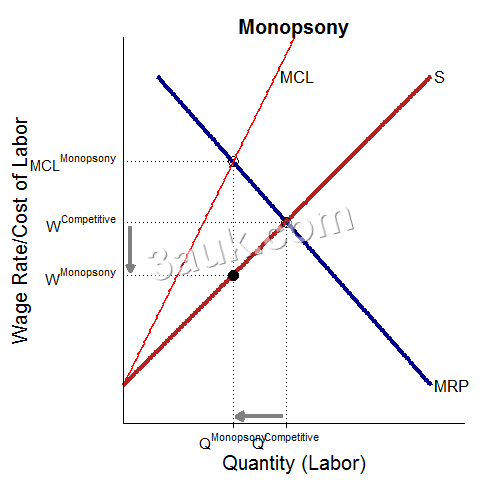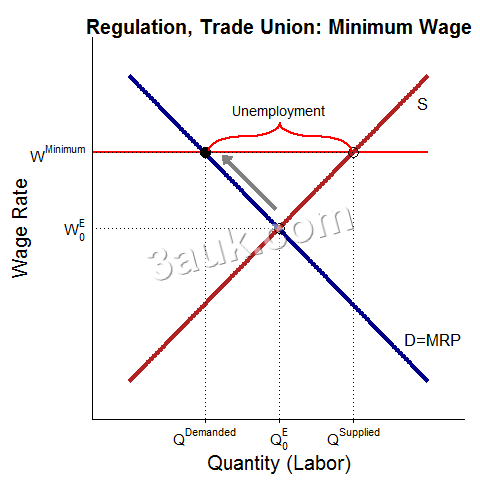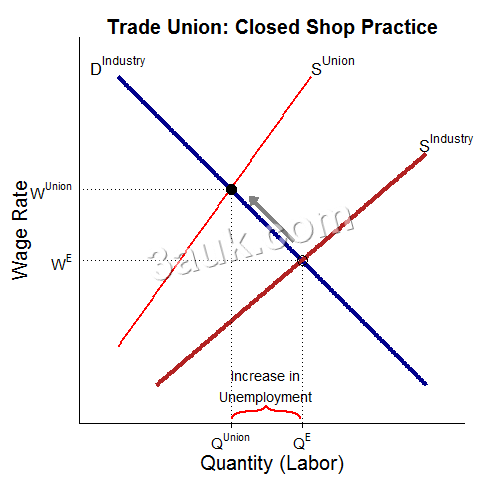- Topic Questions (MCQ – EASY): Labour market forces, MRP theory
- Topic Questions (MCQ – HARD): Labour market forces, MRP theory
Imperfect markets: influence of monopsony employers on wage determination and employment
Monopsony employers have significant market power as the primary buyer of labor in a specific labor market. This power allows them to exert influence over the wage rates and employment levels.
The key characteristics of monopsony employers are:
- Single Buyer: In a monopsony, there is a single employer or a small group of employers dominating the labor market. As the sole or dominant buyer, they have the ability to affect the wage rates.
- Wage Setting Power: Monopsony employers have the power to set wages below the level that would prevail under perfect competition. They can do so by reducing the wage rate to increase their own profits or maintain control over labor supply.
- Elasticity of Labor Supply: The elasticity of labor supply plays a crucial role in wage determination under monopsony.
- If labor supply is elastic, meaning there are alternative job opportunities and workers can easily switch employers, monopsony employers have less bargaining power.
- However, if labor supply is inelastic, such as in rural areas with limited job options, monopsony employers can exert greater control over wages.

The influence of monopsony employers on wage determination and employment can be seen in the following ways:
- Lower Wages: Monopsony power allows employers to pay lower wages than what would prevail under perfect competition. They can exploit their market position to suppress wages and increase their profits.
- Reduced Employment: Monopsony employers may also limit employment levels to maximize their profits. They can hire fewer workers than would be the case in a competitive labor market, leading to lower overall employment levels.
- Wage-Setting Strategies: Monopsony employers may adopt various wage-setting strategies to maintain their control over the labor market. This can include setting wage rates based on workers' individual productivity, engaging in discriminatory practices, or imposing non-compete agreements that restrict workers' mobility.
- Collective Bargaining Power: In some cases, workers may attempt to counter the monopsony power of employers by organizing into labor unions or engaging in collective bargaining. Through collective action, workers can negotiate better wages and working conditions.
imperfect markets: influence of trade unions on wage determination and employment
In imperfect markets, trade unions can have a significant influence on wage determination and employment in a labor market.
- Trade unions are organizations formed by workers to collectively represent their interests and negotiate with employers on issues such as wages, working conditions, and employment terms.
- Their primary goal is to improve the welfare of workers by exerting collective bargaining power.
The influence of trade unions on wage determination in imperfect markets can be seen in the following ways:
- Collective Bargaining: Trade unions engage in collective bargaining with employers to negotiate wages and working conditions on behalf of their members.
- Through this process, trade unions aim to secure higher wages and better benefits for workers.
- The bargaining power of trade unions comes from their ability to mobilize a large group of workers and present a unified front in negotiations.

- Closed shop practice refers to a labor market arrangement where employment in a particular company or industry is restricted to individuals who are members of a specific trade union.
- Under a closed shop system, an employer can only hire workers who are already members of the designated union, or workers must become union members within a specified period after being hired.

- Training and education provided by trade unions can improve labour productivity, thus may potentially increase their wage and employment
- Strike Action: Trade unions have the power to organize strikes or other forms of industrial action as a means to pressure employers into meeting their demands. By disrupting production or services, unions can create significant costs for employers, which can incentivize them to concede to workers' demands for higher wages or improved working conditions.
- Union Density: The level of union membership or union density within a labor market can influence wage determination. Higher union density means a larger proportion of workers are members of trade unions, giving unions more leverage in negotiations and increasing the likelihood of achieving favorable wage outcomes.
- Countervailing Power: Trade unions act as a counterbalance to the power of employers in labor market negotiations. They provide workers with a collective voice and a platform to address power imbalances. By representing the interests of workers, trade unions aim to counteract the influence of monopsonistic or oligopsonistic employers who may have the ability to suppress wages.
The influence of trade unions on employment in imperfect markets is complex. While higher wages negotiated by unions may benefit their members, they can also lead to reduced employment opportunities. Employers facing higher labor costs may respond by reducing hiring or making other adjustments to their workforce. This trade-off between higher wages and potential employment effects is an ongoing debate within labor economics.
Factors that affect TU's bargaining power
- proportion of all workers joining the TU (also called density of TU)
- ease to replace current workers with capital or substitute
- profit margin
- proportion of wage in cost of production
- PED for the product (if inelastic, easier to raise prices to cover the higher costs)
- law
imperfect markets: influence of government on wage determination and employment using a national minimum wage
A national minimum wage is a legally mandated floor on the wage rate that employers must pay to their workers.
- It sets a baseline level below which wages cannot legally fall.
- The government establishes the minimum wage to ensure that workers receive a fair and adequate level of compensation for their labor.

The influence of the government on wage determination and employment through a national minimum wage can have several effects:
- Wage Floor: The national minimum wage establishes a minimum level of compensation that employers must pay their workers. It prevents wages from falling below a certain threshold, which can help improve the living standards of low-wage workers.
- Worker Protection: The minimum wage provides a level of protection for workers by ensuring they receive a minimum level of income. It helps to prevent exploitation and ensures that workers are not paid unreasonably low wages.
- Reducing Income Inequality: By setting a minimum wage, the government aims to address income inequality by raising the wages of low-income workers. It can help narrow the gap between high and low earners and promote more equitable distribution of income.
- Employment Effects: The implementation of a national minimum wage can have both positive and negative effects on employment.
- Advocates argue that it can lead to increased wages and improve workers' purchasing power, stimulating consumer demand and potentially creating additional jobs.
- However, critics argue that higher labor costs resulting from a minimum wage can lead to reduced employment opportunities, particularly for low-skilled workers.
- Compliance and Enforcement: The government plays a crucial role in enforcing the national minimum wage by ensuring employers comply with the law.
- This includes monitoring wage payments, investigating complaints, and imposing penalties on employers who violate the minimum wage regulations.
imperfect markets: bilateral bargaining
In the context of labor markets, bilateral bargaining refers to the negotiation process between an employer and a trade union representing workers.
- The employer and the trade union engage in discussions and negotiations to determine the terms of employment, such as wages, working hours, benefits, and other working conditions.
- The negotiations aim to find a compromise that satisfies both parties' interests.
The outcome of bilateral bargaining depends on several factors, including the bargaining power of each party, the strength of the trade union, the competitive conditions of the industry, and the overall economic environment.
- Bargaining power can be influenced by factors such as the availability of alternative employment options, the scarcity of certain skills, the level of unionization, and the demand and supply conditions in the labor market.
- The optimal outcome is the perfectly competitive wage rate.
- Government minimum wage can have a similar but more direct effect.

limitations of marginal revenue product theory
- Difficulties of accurately measuring marginal productivity and marginal cost of labor
- Firms may not always aim to maximise profits. For example, government jobs, charity
- Ignoring non-wage factors: The MRP theory focuses solely on the productivity of labor and its impact on wages. It does not consider other factors that can influence wages, such as labor market regulations, institutional factors, and social considerations. Non-wage factors, such as working conditions, job security, and fringe benefits, can also play a significant role in determining wages but are not accounted for in the MRP theory.